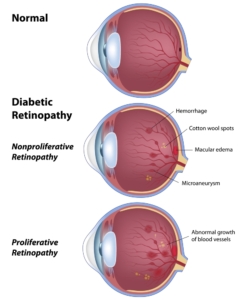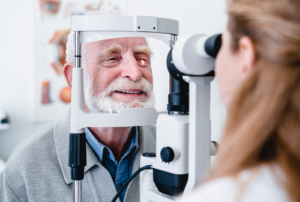Are There Warning Signs with Diabetic Eye Disease?
Do you have diabetes? You may not realize that having diabetes can affect your eyes.
Those with diabetes may develop a diabetic eye disease like diabetic retinopathy. These eye conditions can occur if you’ve had diabetes for a long time or due to uncontrolled blood sugar.
However, you might not even know you have one of these eye conditions. That’s because diabetic retinopathy usually doesn’t have any tell-tale signs, at least initially.
Keep reading to learn more about diabetic retinopathy, its stages, how it can be detected early, and ways timely treatment can help protect your vision.
What is Diabetic Retinopathy?

Diabetic retinopathy is a complication of diabetes that affects your eyes and vision. It happens when high blood sugar levels affect the tiny blood vessels in your retina.
If you have diabetic retinopathy, these blood vessels may swell and leak fluid into your eyes. Diabetic retinopathy usually affects both eyes.
Without prompt treatment, the eye condition can cause permanent blindness. But for this to occur, it typically takes several years before diabetic retinopathy reaches a point where it threatens your vision.
Signs of Diabetic Retinopathy
Often, diabetic retinopathy has no symptoms in the early stages until it’s more advanced. There are few noticeable symptoms in the early stages of diabetic eye disease, including diabetic retinopathy, making it essential to schedule regular dilated eye exams, especially if you have diabetes.
But the same is true even if you think your eyes are healthy. You may experience the following symptoms when diabetic retinopathy has progressed including:

- Blurry or patchy vision
- Eye pain or redness
- Flashes of light
- Floaters in your field of vision
- Difficulty seeing colors
- Gradually worsening vision
- A dark curtain-like shadow over part of your vision
Call your eye doctor immediately to prevent vision loss if you notice abrupt changes in your vision or sudden vision loss.
Stages of Diabetic Retinopathy
Diabetic retinopathy typically develops in four stages over time. They include:
Stage 1: Mild Nonproliferative Diabetic Retinopathy
Microaneurysms or balloon-like bulges form in the retinal blood vessels during the initial stage. These might leak small amounts of fluid into the retina.
However, your sight won’t be affected, and you won’t need treatment.
If you’ve been diagnosed with the first stage of diabetic retinopathy, your eye doctor may recommend making lifestyle changes like managing your glucose levels to prevent the condition from advancing.
Stage 2: Moderate Nonproliferative Diabetic Retinopathy
In the second stage of diabetic retinopathy, swelling in the blood vessels increases. As a result, fluid and blood leak into the macula or the central part of the retina.
Fluid and blood leaking into the macula cause damage and vision changes requiring treatment and frequent eye exams. If you’re diagnosed with stage 2 of diabetic retinopathy, regular exams, treatment, and lifestyle changes can decrease the chances of the condition progressing.
Stage 3: Severe Nonproliferative Diabetic Retinopathy
If your glucose levels are still high, more extensive areas of your blood vessels become blocked, considerably decreasing blood flow. Because of this, you may start experiencing blurred vision with dark spots in your field of vision.
In the third stage of diabetic retinopathy, blood vessels in the retina continue leaking. These significantly affect your eyesight.
At stage 3, you’re at a very high risk of losing your vision. Prompt treatment and lifestyle changes can aid in slowing the condition’s progression and preserving your sight.
Stage 4: Proliferative Diabetic Retinopathy
In the most advanced stage of diabetic retinopathy, retinal blood vessels suffer severe damage, triggering the growth of new blood vessels. However, these blood vessels form abnormally and are weaker, leading to more leaking into your retina.
More fluids and blood in your retina considerably affect your vision and can cause blindness.
Risks of Diabetic Retinopathy
If you have Type 1 or Type 2 diabetes, you’re more likely to develop diabetic retinopathy. You’re also at greater risk of developing the condition if you:

- Regularly have high blood glucose
- Have had diabetes for a long time
- Suffer from high cholesterol
- Have high blood pressure
- Are currently pregnant
- Smoke
- Develop certain illnesses like pneumonia
- Afro-Caribbean or Asian descent
Diabetic Retinopathy Treatment
There is no cure for diabetic retinopathy. However, treatments like anti-VEGF injections work quite well to minimize, delay, or prevent vision loss.
These treatments are most effective if the condition has been diagnosed and treated as early as possible. Anti-VEGF (Vascular Endothelial Growth Factor) is a treatment option that slows the formation of abnormal blood vessels in your retina.
The growth of these blood vessels is encouraged by a protein known as vascular endothelial growth factor or VEGF. Anti-VEGF therapy decreases the effects of VEGF.
The treatment can also help reduce the size of new blood vessels. Anti-VEGF involves injecting the medication into the back of the eye. The treatment is an antibody that binds to and eliminates the excess VEGF, reducing the growth of new blood vessels.
For the best results, anti-VEGF injections must be started before or after the new retinal blood vessels and swelling appear.
How to Reduce Your Risk for Diabetic Retinopathy
Frequent eye exams can help lead to the earliest diagnosis of the eye condition when treatment is likely to help save your remaining vision.

Other ways to lower your chances of developing diabetic retinopathy or prevent it from worsening include:
- Quitting smoking if you’re a smoker
- Taking your diabetes medication exactly as prescribed
- Keeping your blood sugar, cholesterol, and blood pressure in check
- Ensuring your eye doctor knows of any vision changes without delay
- Maintaining a healthy diet and exercising regularly
Protect Your Vision from Diabetic Retinopathy
Diabetic retinopathy is a sight-threatening condition. But it doesn’t have to rob you of your vision.

At Eye Consultants of North Dakota, our experienced team of ophthalmologists can diagnose diabetic retinopathy during a comprehensive exam and provide timely treatment to save your remaining sight.
Learn more about your options for treating diabetic retinopathy by requesting an appointment at Eye Consultants of North Dakota in Fargo, ND, today!



